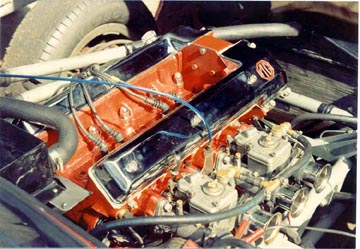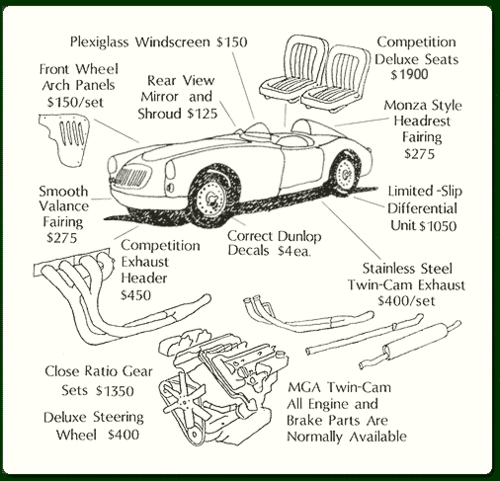MG Engine Swaps Forum
Beat the heat: some theory behind the problem.
Posted by NOHOME
|
Topic Creator (OP)
Jul 28, 2008 09:51 PM
Top Contributor
Joined 17 years ago
18,560 Posts
|
|
Found some good reading from a poster over on the Miata V8 board. Those guys have very similar temperature issues with big engines in small cars.
http://www.autospeed.com/A_2159/cms/article.html
http://www.autospeed.com/A_2160/cms/article.html
http://www.autospeed.com/cms/A_2162/article.html
may be old stuff or basic for some of you, but it is a good article on what we are figthing when it comes to cooling these engines.
Pete
http://www.autospeed.com/A_2159/cms/article.html
http://www.autospeed.com/A_2160/cms/article.html
http://www.autospeed.com/cms/A_2162/article.html
may be old stuff or basic for some of you, but it is a good article on what we are figthing when it comes to cooling these engines.
Pete
|
dhen
Darian Henderson
|
Jul 28, 2008 09:58 PM
Joined 16 years ago
1,040 Posts
|
|
Jul 28, 2008 11:20 PM
Joined 17 years ago
2,059 Posts
|
|
The articles talk about using a Dwyer Magnehelic differential pressure gauge to assess pressures in various locations so that sensible decisions can be made about cooling vents, spoilers, trays, etc. This topic was previously discussed (along with actual measurements taken on an MGB-GT) in this British V8 article: http://www.britishv8.org/Articles/MGB-Cold-Air-Induction.htm
|
Jul 29, 2008 09:34 AM
Top Contributor
Joined 19 years ago
15,793 Posts
|
|
|
Topic Creator (OP)
Jul 29, 2008 10:10 AM
Top Contributor
Joined 17 years ago
18,560 Posts
|
|
Carl:
If you had made the louvers in the inner fenders, which way would they point? Open side to the front of the car or to the rear.
Intuition and aesthetics dictate rear facing. Not so sure if this is a good assumption. The wheel well is a low pressure area, so it will pull air out regardless is what I am thinking. One direction will pull the air from the rear of the compartment, and the other will allow the hot air from the rad to go out the front facing openings.
Pete
If you had made the louvers in the inner fenders, which way would they point? Open side to the front of the car or to the rear.
Intuition and aesthetics dictate rear facing. Not so sure if this is a good assumption. The wheel well is a low pressure area, so it will pull air out regardless is what I am thinking. One direction will pull the air from the rear of the compartment, and the other will allow the hot air from the rad to go out the front facing openings.
Pete
|
Jul 29, 2008 10:52 AM
Top Contributor
Joined 19 years ago
15,793 Posts
|
|
|
Topic Creator (OP)
Jul 29, 2008 11:02 AM
Top Contributor
Joined 17 years ago
18,560 Posts
|
|
Carl:
I like the idea. The only way I can see to do the louvers is to cut out the piece of inner fender, run the piece through a bead roller with a set of slitting dies to make the louver, and then weld the piece back in.
Just patching in a vent with louvers would fail the eye appeal test.
Pete
I like the idea. The only way I can see to do the louvers is to cut out the piece of inner fender, run the piece through a bead roller with a set of slitting dies to make the louver, and then weld the piece back in.
Just patching in a vent with louvers would fail the eye appeal test.
Pete
|
Jim Blackwood
* BlownMGB-V8
Gunpowder Rd, Florence, KY, USA
Sign in to contact
|
Jul 30, 2008 10:01 AM
Top Contributor
Joined 17 years ago
8,013 Posts
|
|
rficalora
ROB FICALORA
|
Jul 30, 2008 11:22 AM
Joined 18 years ago
2,860 Posts
|
I read the articles on the plane, but it all talks about air flow at speed. Who has problems with that in their B? Seems like the more interesting topic is getting sufficient air flow when the car is sitting still or crawling in a traffic jam. I believe Curtis' article may have mentioned that but I did't get to re-read it because my printer ran out of ink before I got to that one (I printed the articles to read on the plane)
|
Jul 30, 2008 11:38 AM
Top Contributor
Joined 19 years ago
15,793 Posts
|
|
NOHOME Wrote:
I was actually looking into making the louvers without removing the metal. I was thinking there should be a tool similar to a hydraulic knockout pucnh that would make the louver on the car. Drill a small hole at each end, make a cut from one hole to the other, then assemble a two piece mandrel, & use the hydraulic pump to form the louver. I haven't been able to find such a tool.
Kurt Schley sent me an old article years ago on making homemade louvers. I think the technique they used would be very difficult to do on the car instead of on a workbench. Removing a patch from the car, then welding it back in after the louvers are punched would probably be the easiest.
Quote:
Carl:
I like the idea. The only way I can see to do the louvers is to cut out the piece of inner fender, run the piece through a bead roller with a set of slitting dies to make the louver, and then weld the piece back in.
Just patching in a vent with louvers would fail the eye appeal test.
Pete
I like the idea. The only way I can see to do the louvers is to cut out the piece of inner fender, run the piece through a bead roller with a set of slitting dies to make the louver, and then weld the piece back in.
Just patching in a vent with louvers would fail the eye appeal test.
Pete
I was actually looking into making the louvers without removing the metal. I was thinking there should be a tool similar to a hydraulic knockout pucnh that would make the louver on the car. Drill a small hole at each end, make a cut from one hole to the other, then assemble a two piece mandrel, & use the hydraulic pump to form the louver. I haven't been able to find such a tool.
Kurt Schley sent me an old article years ago on making homemade louvers. I think the technique they used would be very difficult to do on the car instead of on a workbench. Removing a patch from the car, then welding it back in after the louvers are punched would probably be the easiest.
|
Duncan
Duncan Cowen
|
Jul 30, 2008 11:46 AM
Joined 16 years ago
1,650 Posts
|
|
Jul 30, 2008 12:38 PM
Top Contributor
Joined 19 years ago
15,793 Posts
|
|
I think tires would sling the water straight up into the engine compartment if the louvers faced down. It may do it regardless of orientation. I'm counting on the airflow out of the engine compartment to get most of the water out. Besides, I really, really try to avoid driving my MG in the rain! 

|
Jul 30, 2008 12:57 PM
Top Contributor
Joined 19 years ago
17,991 Posts
|
|
The MGA Twin Cam had removable inner fender panels (the lower part only, behind the shock position) with louvers in them.
I don't see why someone couldn't come up with a similar panel they could sell, along with a template for cutting out the stock MGB inner fender, and for drilling for small Dzus fasteners to fit the replacement panels.
Here is a pic of the MGA panels.
Bill Spohn www.rhodo.citymax.com/carstuff.html
Current: 1958 MGA Twincam (race car (170 bhp)),1962 MGA Deluxe Coupe (98 bhp)
1957 Jamaican MGA (200 bhp)1965 1971 Jensen Interceptor (350 bhp)
2009 Pontiac Solstice GXP Coupe (375 bhp)
2007 BMW Z4M coupe (340 bhp)
Recent: 1969 MGC roadster (175 bhp),Jensen CV8 (375 bhp),
1969 Lamborghini Islero S (350 bhp), 1988 Fiero GT turbo (300 bhp)
North Vancouver BC

I don't see why someone couldn't come up with a similar panel they could sell, along with a template for cutting out the stock MGB inner fender, and for drilling for small Dzus fasteners to fit the replacement panels.
Here is a pic of the MGA panels.
Bill Spohn www.rhodo.citymax.com/carstuff.html
Current: 1958 MGA Twincam (race car (170 bhp)),1962 MGA Deluxe Coupe (98 bhp)
1957 Jamaican MGA (200 bhp)1965 1971 Jensen Interceptor (350 bhp)
2009 Pontiac Solstice GXP Coupe (375 bhp)
2007 BMW Z4M coupe (340 bhp)
Recent: 1969 MGC roadster (175 bhp),Jensen CV8 (375 bhp),
1969 Lamborghini Islero S (350 bhp), 1988 Fiero GT turbo (300 bhp)
North Vancouver BC

|
Jim Blackwood
* BlownMGB-V8
Gunpowder Rd, Florence, KY, USA
Sign in to contact
|
Jul 30, 2008 01:55 PM
Top Contributor
Joined 17 years ago
8,013 Posts
|
bills Wrote:
Using that in the B would compromise the body strength forward of the firewall, requiring reinforcement in some other way. Otherwise you are very likely to develop cracks in the inner fender along the forward corners of the cutout. Using RV8 cutouts for vents like Kurt did makes more sense and the expanded metal covers he used looked just fine. He said he didn't have much trouble at all with water coming in there.
Jim
Quote:
The MGA Twin Cam had removable inner fender panels (the lower part only, behind the shock position) with louvers in them.
Using that in the B would compromise the body strength forward of the firewall, requiring reinforcement in some other way. Otherwise you are very likely to develop cracks in the inner fender along the forward corners of the cutout. Using RV8 cutouts for vents like Kurt did makes more sense and the expanded metal covers he used looked just fine. He said he didn't have much trouble at all with water coming in there.
Jim
|
Sidney, IL, USA
Sign in to contact
1969 MG MGB V8 Conversion "Xenia"
1969 MG MGC GT 1969 MG MGC GT "Foxy" 1978 MG MGB V8 Conversion "Lucky Lady" & more |
Jul 30, 2008 04:44 PM
Joined 17 years ago
520 Posts
|
V8MGBV8 Wrote:
I was worried about the same thing myself when I cut mine similiar to RV8 openings.
As the inner fenders are negative pressure zones (mentioned above), at speed hardly any road debris/water will enter the engine compartment as it is forced out under the car.
I think more dust/bugs/rain enter through the grille!!
Cheers
Pete
69 B 302 V8 - 78 B 215 V8 - 80 B 302 V8 - 58 ZB Magnette - 69 CGT 9004 - 69 CGT 7666
http://www.mantellmotorsport.com/
Quote:
I think tires would sling the water straight up into the engine compartment if the louvers faced down. It may do it regardless of orientation. I'm counting on the airflow out of the engine compartment to get most of the water out. Besides, I really, really try to avoid driving my MG in the rain!
I was worried about the same thing myself when I cut mine similiar to RV8 openings.
As the inner fenders are negative pressure zones (mentioned above), at speed hardly any road debris/water will enter the engine compartment as it is forced out under the car.
I think more dust/bugs/rain enter through the grille!!
Cheers
Pete
69 B 302 V8 - 78 B 215 V8 - 80 B 302 V8 - 58 ZB Magnette - 69 CGT 9004 - 69 CGT 7666
http://www.mantellmotorsport.com/
Member Services:
MGB 302 V8 Install Kits, V8 Installs, V8 Conversion Parts, Restorations, Fiberglass Body kits for the MGB and MG Servicing.
Contact Pete at 217-649-7717 pete@mantellmotorsport.com or visit www.mantellmotorsport.com - Check us out on Facebook too!
Forums 

Having trouble posting or changing forum settings?
Read the Forum Help (FAQ) or contact the webmaster

















